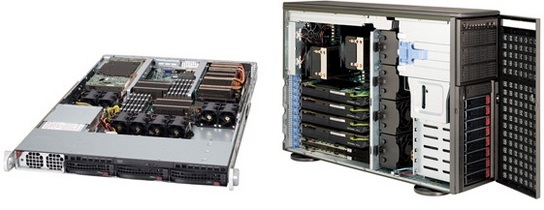Supermicro to expand their GPU servers to include Fermi-level Tesla
by Ian Cutress on May 4, 2010 11:31 AM EST- Posted in
- IT Computing
Supermicro have launched today their second generation of GPU computing servers, using NVIDIA Tesla 20-series GPUs. This product line is an upgrade from their first generation servers, and features a 1U server with 2x M2050 Tesla cards; a 4U tower that supports four C2050 Tesla GPUs, three other PCI-E cards, and support for eight hot-swappable 3.5" SAS/SATA drives; and a 2U twin server that supports two hot-pluggable GPU nodes and onboard QDR InfiniBand for 40GB/sec connectivity.

The NVIDIA Tesla M2050 is a workstation level version of the GTX470 with 448 CUDA cores, but with 3GB GDDR5 ECC memory and a passive heatsink. The C2050 is an M2050 with an increased memory bandwidth (144GB/sec to 148GB/sec) due to faster memory, and is actively cooled.
All Supermicro systems are compatible with dual Intel Xeon 5500/5600 processors (up to 16 threads) and 192GB Registered ECC DDR3-1333Mhz RAM. Both the 1U server and 4U tower are supplied with a redundant 1400W Gold level (93%) high efficiency power supply. Makes you wonder though for the 4U unit - four Fermi cards, two Nehalem Xeons, is 1400W enough?
NVIDIA Tesla cards and their computing languages have been welcome technologies in various computational scientific fields over these past few years - medical imaging, oil and gas exploration, quantum chemistry, financial simulation, astrophysics, folding and various BOINC projects to name but a few. A few companies have started to offer GPU integration into their server systems, and Supermicro has always been on my list of companies to watch out for with regards Tesla workstations in my day-to-day job (computational chemistry).
In terms of pricing, think a few thousand dollars per Tesla GPU, $1000 for two Xeon 5520s and cooling, $2000 for the power supply, 4U tower, and general cooling, $1000 for the motherboard, and $500-$20000 for how much RAM you would like. Coming soon to a Supermicro approved reseller near you (if you can afford it)!










23 Comments
View All Comments
GullLars - Tuesday, May 4, 2010 - link
With the price tag on this thing, you could mount water cooling, drag the cables outside, and hook up a 1m² radiator with a suiting fan. Doing it your self would probably void warranty though :PMySchizoBuddy - Tuesday, May 4, 2010 - link
Are GPU based computers listed on the Top500 Supercomputer list?MySchizoBuddy - Tuesday, May 4, 2010 - link
we need editing featureI meant GPU based SuperComputers
mfago - Tuesday, May 4, 2010 - link
The NCSA Lincoln cluster:http://www.ncsa.illinois.edu/UserInfo/Resources/Ha...
was ranked in Top500 in 2006, but is not listed any longer.
IanCutress - Tuesday, May 4, 2010 - link
The Tianhe-1 system at No. 5, which is a hybrid design with Intel Xeon processors and AMD GPUs. The TH-1 uses AMD GPUs as accelerators. Each node consists of two AMD 4870 GPUs attached to two Intel Xeon processors.Ian
zyren - Tuesday, May 4, 2010 - link
These prices for the tesla cards are starting to get ridiculous. Last generations tesla cards were roughly $1300 for a 4gb model, which had the same amount of cores as the 280gtx. This years c2050, which is equivalent to the 470gtx except with 3gb of ram is $2500. The c0207, which si equivalent to the 480gtx with 6gb, is $4000. I was planning on building a 4 GPU workstation for around $10k but thats not happening. I might as well just buy 4 480gtx's and save myself a ton of money for the same performance. Sorry, but im not paying $14k for extra ram, especially when last years model was nowhere near that much.mfago - Tuesday, May 4, 2010 - link
Well, if you need double precision then NVIDIA forces you to buy the Tesla. For some applications the extra RAM is necessary too.IanCutress - Tuesday, May 4, 2010 - link
The GTX260 and above on the 200 line, and the GTX 470 and 480, also have double precision. The Teslas are just highly tested, ECC RAM, more RAM per GPU, and longer warranty, than their non-Tesla brethren. ECC errors due to cosmic radiation at most are one bit per gigabyte per hour, so depending on your algorithm and simulation (e.g. continuous function simulation vs random walk/brownian motion) depends on whether ECC or double precision is required.Ian
mfago - Wednesday, May 5, 2010 - link
While the GTX 470 and 480 have double precision support, NVIDIA has decided to artificially limit the performance to 25% of the Tesla cards. Thus, while they support them, the performance is pitiful compared to both the Radeon 5870 and the Teslas.EJ257 - Tuesday, June 1, 2010 - link
I thought the higher prices are for the ECC RAM, more RAM than normal GTX470/480s and also the 3-yr warranty + 24/7/365 support. Otherwise the Tesla cards perform just like the GTX470/480 right?